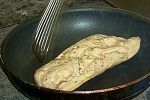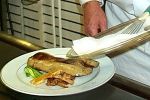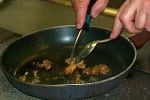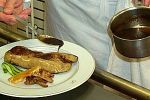Preparation time: 15 minutes
Waiting time: 8 heures
Cooking time: 11 minutes
Chef's Tips
Since the liver may have come into contact with gall, it is always best to add a little sugar to cut the bitterness. You could say it's a good cover-up - just a gram of sugar, which isn't much, will ensure that the foie gras is perfect. You can also replace the sugar with a little Monbazillac (a sweet wine from southwestern France), Sauternes or another sweet wine in the dry marinade.
A Quick Jus
You can simply deglaze the pan containing the cooking fat from the liver with a little balsamic vinegar - this makes a very quick jus.
Step by step:

Remove the veins from the foie gras, season using 12 g (scant half ounce) salt, 2 g of pepper and 1 g of sugar per kilogram (2.2 lb.) of foie gras.
I always add a little nutmeg which brings out the flavour of the foie gras.
Let it rest at least half a day in the refrigerator.

Take a very hot non-stick pan - caramelize the foie gras quickly; don't be afraid to brown it well.

Turn and caramelize the other side.

Place in a cocotte; put into a 180° C (350° F) oven for about 10 minutes until the heat reaches the centre - the foie gras is fine when the centre reaches 56° C (112° F) - this is the point at which it is "edible" because germs are destroyed. It's important to keep in mind that ducks tend to eat a little of everything. They're not very clean animals, so this way any germs that may be present in the liver are killed.
To know if the foie gras is cooked, you can pierce it with a fork and place it on your tongue. If it's warm, it's fine. It doesn't have to be extremely hot.

Sear the chanterelles in a very hot skillet with a knob of butter.
If necessary, cut a little gash in them with the point of a knife to keep them flat.

I really like to accompany seared foie gras with Périgueux sauce (brown sauce with truffles and Madeira.)
***** CODE PUB = PUB_F *****

-

 Recipes
Recipes
-

 Products
Products
-

 Entertaining
Entertaining
-

 Chefs
Chefs
-

 Hints & Tips
Hints & Tips
-

 Glossaries
Glossaries










